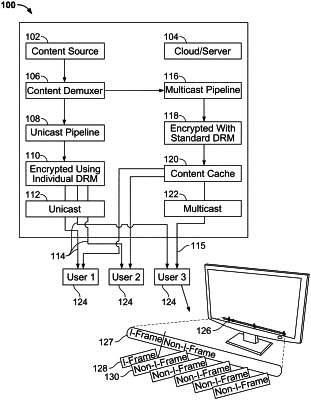| CPC H04N 21/23895 (2013.01) [H04N 21/2393 (2013.01); H04N 21/6131 (2013.01); H04N 21/6405 (2013.01); H04N 21/8456 (2013.01)] | 20 Claims |

|
1. A method for transmitting a content item to a user device, the method comprising:
receiving, at a content source, a request for the content item from the user device;
splitting, using a demultiplexer, a digital stream into a first video signal of the content item and a second video signal of the content item;
transmitting, via a unicast server using a first delivery protocol, the first video signal for the content item to the user device;
transmitting, via a multicast server using a second delivery protocol, the second video signal for the content item to the user device;
generating for presentation on the user device the first video signal followed by the second video signal;
during presentation of the content item on the user device:
receiving, from the user device, a sequence of intraframe and non-intraframe segments based on presentation of the content item on the user device;
receiving messages associated with each segment of the sequence as the sequence is presented on the user device;
determining, based on the messages, out-of-order messages indicative of delivery of the content item for the user device being behind; and
based on the out-of-order messages indicative of delivery of the content item for the user device being behind, switching from transmitting the first video signal via the unicast server using the first delivery protocol to transmitting the first video signal via a server that uses a third delivery protocol different from the first delivery protocol and the second delivery protocol.
|